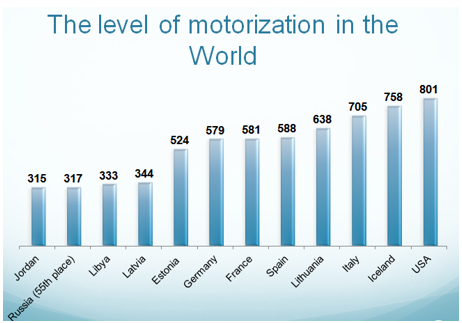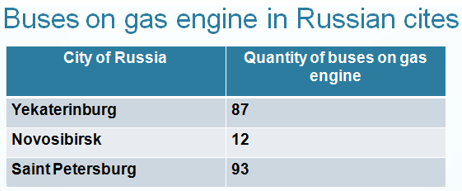Срочная публикация научной статьи
+7 995 770 98 40
+7 995 202 54 42
info@journalpro.ru
Innovations ways to reduce the negative effects of motorization in Russia
Рубрика: Технические науки
Журнал: «Евразийский Научный Журнал №2 2017» (февраль, 2017)
Количество просмотров статьи: 2602
Показать PDF версию Innovations ways to reduce the negative effects of motorization in Russia
Khegay Valentina Dmitrievna
Far Eastern Federal University
Engineering school, Department of Innovation,
quality, standardization and certification
E-mail: by_valentine@mail.ru
Key worlds: innovation, ecology, negative effects, motorization, traffic accidents, noise and vibration, air pollution.
Every year the number of cars is increasing and Russia is ranking 55th in the World regarding the number vehicles (picture 1). On average the number of vehicles increases by one point five million per year. Motorization has a positive effect on the economy and social development in the country, but there is also a lot of negative effects.

Picture 1 — The level of motorization in the World
The most important of which are:
— traffic accident;
— noise and vibration;
— traffic jams;
— increased concentration of air pollution;
— reducing the mobility of people [3].
Traffic accident a very urgent problem in Russia. This is way this problem is given a higher priority than the others.
There is a range of possible solutions:
— no longer using gasoline automobile in favor of gas, electric motors and hybrids;
— creating conditions for the development of bicycle transport;
— increase of the competitiveness and attractiveness of public transport;
— improvement of the road network, in particular the construction of bypass roads, including for heavy vehicles.
Currently there are to approaches Russia is pursuing: on the one hand creating conditions for the development of bicycle transport. On another hand is no longer using gasoline automobile in favor of gas, electric motors and hybrids.
In 2011 Russia’s cites started to use gas driver busses for passenger transport. Nowadays these buses are running in Yekaterinburg, Novosibirsk, Saint Petersburg (pictures 2).

Pictures 2 — Buses on gas engine in Russian cites
Vladivostok city is the second place of motorization in Russia. But in Vladivostok there is no buses are not enough developed infrastructure — there are no gas filling stations.
As for creating conditions for the development of bicycle transport. In Vladivostok it is very difficult to draw. Because Vladivostok’s relief have a lot of raising and lowering and location in colder climates zone.
The only place where can freely ride a bike is campus of Far Eastern Federal University on the Russky island, which as built five years ago.
The most effective way for Vladivostok is construction of by pass and traffic interchange. But this ay is very expensive for this city. Vladivostok located by the sea. Five years ago there were bridges constructed in this city. It is possible to reduce the intensity on certain roads about 40%.
In our days there is another project — Vladivostok Ring Road. This is an alternative way that will take the flow of heavy vehicles away from the city centre [1].
In the city center Vladivostok located by sea port. Therefore heavy vehicles are accumulated near seaport. There are sources of noise, vibration and air pollution. This ring road will reduce congestion on the roads of Vladivostok
Findings showed that after the construction of Vladivostok ring road traffic intensity in the city centre will be reduced by
But in our days in Russia is implementing the transport strategy until 2030, which will reduce some indicators:
— the social risk of death in road accidents (death toll per 100 thousand population) is expected to decline from 23,5 in 2007 to 8 in 2030;
— the volume of polluting harmful substances from road transport should be reduced by 440%;
— the share of alternative fuels in total fuel consumption is expected to increase from 1% to 35%;
— the share of waste utilization in road transport should increase from 50% to 90% [2].
The transport strategy should improve the environment of the Russian city by reducing the negative effects of motorization.
References
- Хегай В.Д. Зачем приморской столице Владивостокская кольцевая автодорога? Материалы Всероссийской научно-практической конференции „Инженерные науки: актуальные проблемы и перспективы развития”, Владивосток:
128-131, 2014. - Pogotovkina N.S., Almetova Z.V., Gorchakov Y.N., Kosyakov S.A., Khegay V.D. Motorization in Russia: challenges and solutions. International Journal of Applied Engineering Research (10):
34443-34448, 2015; - Ugay S.M., Pogotovkina N.S. Quality assessment of transport service of the passengers in Vladivostok (Russia).World Applied Sciences Journal 24 (6):
809-813, 2013;









